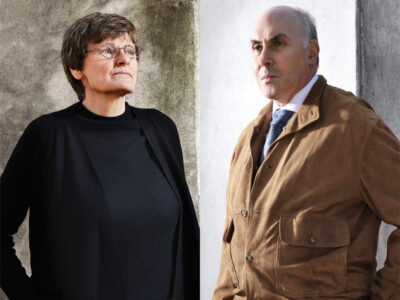
Sitting in his office in the orthopaedic surgery department at the Hospital of the University of Pennsylvania, L. Scott Levin uses his hands to gesture, point, wave, wipe his eyes, and brush his nose. He’s doing this not because he has a cold or an itch, but to demonstrate all of the ordinary things the patient he operated on can now finally do.
Levin, the director of the Penn Hand Transplant Program and chairman of the orthopaedic surgery department, had done something rather less ordinary. Along with a team of Penn surgeons, nurses, and anesthesiologists, he had successfully completed the first double hand transplant in the region. The patient, a young woman who declined to speak with the press, had lost both of her arms and legs to an infection before undergoing the complicated, 11-hour procedure at HUP in September. Penn Medicine announced the extremely rare surgery on November 1, and while the patient remains in a heavy rehabilitation program to gain full use of her fingers, Levin says she is doing “extremely well” and “can now start to do the basic functions that allow her to reintegrate into society.” More than two months after the surgery, her body has shown no sign of rejecting the new limbs, which is one of the biggest hurdles of any transplant.
“This is a landmark operation that really sets the stage for the entire development of our hand transplant program,” Levin says. “I think at Penn, with the team we’ve now assembled, we have the opportunity to be world-class leaders in this new field.”
Because of the risks and complications involved with surgically reattaching limbs from a deceased donor (a field known as vascularized composite allotransplantation), Penn Medicine is only the seventh center in the United States to perform a hand transplant and just the third to successfully perform the surgery on both hands. It took the Penn team approximately two years to screen the patient and rehearse for the procedure, which involved, among other things, connecting bones, blood vessels, nerves, muscles, tendons, and skin to the recipient, just below the elbow. To find the right donor, Penn partnered with the Gift of Life Donor program, a local nonprofit organ and tissue donor program. That also came with far more complications than your typical organ transplant.
“Our screening process was a little different than the heart, lung, and kidney guys,” says Benjamin Chang, co-director of Penn’s Hand Transplant Program and the associate chief of the plastic surgery division. “We had to look for someone that was the right race, the right size, the right sex, the right hairiness—all of those things.”
Levin calls the collaboration a “tour de force,” in which nurses, anesthesiologists, infectious-disease experts, transplant experts, physical therapists, social workers, dieticians, plastic surgeons, and orthopedic surgeons all came together to prepare for the operation and then to monitor the patient in post-operative care.
“There are very few places in the world where you can assemble a team like this in one institution,” Levin says. Chang agrees, noting that at other medical centers, sometimes rivalries or even “bad blood” exist between plastic surgeons and orthopedic surgeons. “This was one of the only places where I interviewed where the two groups were not only cordial but actually worked together,” Chang says.
To bring the entire team together, Chang credits Levin, who came to Penn from Duke Medical Center in July 2009 and was tasked with running the newly formed Hand Transplant Program a year-and-a-half later, along with Abraham Shaked, director of Penn’s Transplant Institute. Upon his arrival, Levin immediately went to work, recruiting and convincing other people in different departments to help with the procedure.
“The first thing I noticed about him was he was very enthusiastic and energetic,” Chang says of Levin. “To get a big project like this off the ground, you really need someone like that who has a motor running all the time. He was very optimistic about being able to get things done.”
In truth, Levin’s ambition to give amputees a better life was formed long before he got to Penn. From 1989 to 1998, the orthopedic surgeon served in the military, where he treated mutilated soldiers from Desert Storm and later at the Landstuhl Regional Medical Center in Germany, a military hospital operated by the US Army and the Department of Defense that treats wounded soldiers from Iraq and Afghanistan.
“That’s a very high priority, to be able to offer our wounded warriors this kind of technology,” Levin says. “That is probably the most motivating factor for me personally.”
At a recent conference in Washington, Levin and others in the field discussed how many soldiers would benefit from hand transplantation, and determined that “the number is considerable,” Levin says. In the future, he hopes Penn Medicine will treat these victims of war, primarily quadramembral amputees, who have lost both legs and arms. With time, he also hopes to explore allotransplantations for elbows, knees, faces, and more. “Any body part you can think of,” Levin says, “we can transplant.”
Of course, while the possibilities are invigorating, these types of procedures are still in their early stages—the world’s first bilateral hand transplant was performed in France in 2000—and questions remain about their long-term feasibility. Chang hopes donating limbs will eventually become just as commonplace as donating organs, but knows that could be a steep hill to climb because, as he says, “no one’s ever seen their kidneys.”
“I can’t tell you right now if in 20 years this will be a routine part of surgery or if it will be one of those things we tried and it wasn’t such a good thing,” he adds. “But I think the only way you can tell is if you actually do it. We weren’t planning for this to be a one-time stunt. We really want to be able to build on this and use the publicity to help encourage people’s families to donate limbs.”
After seeing what the team he assembled was able to accomplish on their first try, Levin has fewer doubts about what lies ahead.
“There is no question in my mind this is the future of reconstructive surgery,” he says. “And the future is what has energized me the most.”
—Dave Zeitlin C’03




